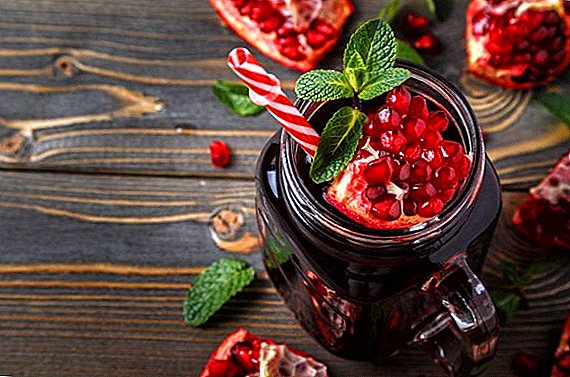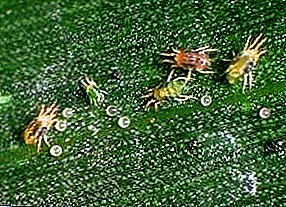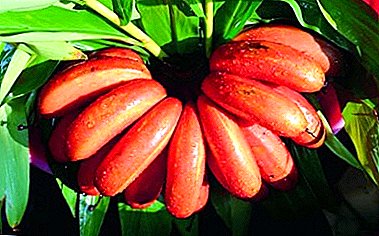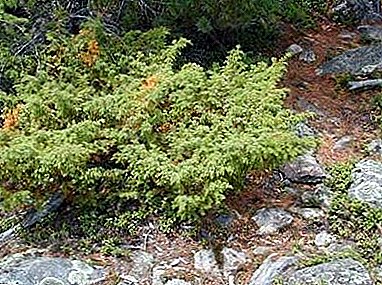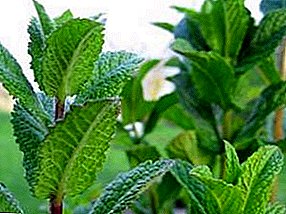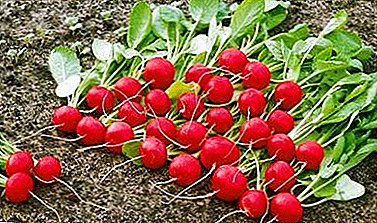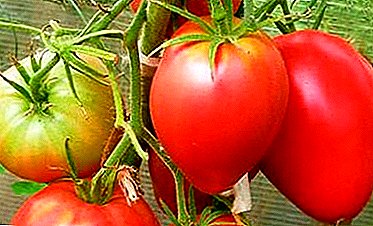
Sensei is a great variety for anyone who loves sweet, fleshy, large tomatoes.
It is undemanding to care, but loves dressing, reacting with an excellent harvest. Grown in greenhouses, under the film or in the beds, fruits until frost.
Read further in the article a detailed description of the Sensei variety, get acquainted with its characteristics and appearance on the photo. We will also tell about the features of growing.
Tomato Sensei: variety description
| Grade name | Sensei |
| general description | Early ripe determinant variety of tomatoes for cultivation in greenhouses and open ground. |
| Originator | Russia |
| Ripening | 100-105 days |
| The form | Round-heart-shaped, with pronounced ribbing in the stem |
| Colour | Red and crimson |
| Average tomato mass | up to 400 grams |
| Application | Universal |
| Yield varieties | 6-8 kg from 1 plant |
| Features of growing | Agrotechnika standard |
| Disease resistance | Resistant to major diseases of tomatoes |
 Sensei is an early ripe high-yielding variety. Bush determinant, compact, stem-type. About indeterminantny grades read here. In greenhouses it grows up to 1.5 m, on open beds it looks more miniature.
Sensei is an early ripe high-yielding variety. Bush determinant, compact, stem-type. About indeterminantny grades read here. In greenhouses it grows up to 1.5 m, on open beds it looks more miniature.
The amount of green mass is moderate, the leaf is simple, dark green, medium-sized. Tomatoes ripen in small brushes of 3-5 pieces. Fruiting lasts until frost, the last tomatoes break in the stage of technical ripeness for ripening at room temperature.
Fruits are large, fleshy, weighing up to 400 g. The shape is rounded-heart-shaped, with pronounced ribbing at the stem. The color of ripe tomatoes is juicy red and raspberry. The flesh is tender, homogeneous, low seed, sugary. The taste is intense, sweet, refreshing.
You can compare the weight of fruits with other varieties in the table below:
| Grade name | Fruit weight |
| Sensei | up to 400 grams |
| Doll | 250-400 grams |
| Summer resident | 55-110 grams |
| Lazy man | 300-400 grams |
| The president | 250-300 grams |
| Buyan | 100-180 grams |
| Kostroma | 85-145 grams |
| Sweet bunch | 15-20 grams |
| Black bunch | 50-70 grams |
| Stolypin | 90-120 grams |
Specifications
Variety of tomato Sensei Siberian breeding, suitable for cultivation in various regions. Tomatoes can be grown in greenhouses, greenhouses or open ground.
Yield stable, highly dependent on the intensity of care. Harvested fruits are well kept, suitable for transportation. Sensei tomatoes are ideal for salads, hot dishes, soups, sauces, mashed potatoes. Ripe fruit makes a delicious thick juice. Suitable for baby and diet food.
You can compare the yield of this variety with others in the table below:
| Grade name | Yield |
| Sensei | 6-8 kg per square meter |
| Nastya | 10-12 kg per square meter |
| Bella Rosa | 5-7 kg per square meter |
| Banana red | 3 kg from a bush |
| Gulliver | 7 kg from a bush |
| Lady shedi | 7.5 kg per square meter |
| Pink Lady | 25 kg per square meter |
| Honey heart | 8.5 kg from a bush |
| Fat jack | 5-6 kg from a bush |
| Broody | 10-11 kg per square meter |
Among the main advantages of the variety:
- high taste of fruits;
- good yield;
- resistance to major diseases of the nightshade.
There are no drawbacks in the Sensei tomato variety. The only difficulty is the need to form bushes with a pinch and the sensitivity of tomatoes to the quality and quantity of top dressing.
 Read also on our website: How to get a good crop of tomatoes in the open field? What are the subtleties of agricultural technology to be considered when growing early varieties?
Read also on our website: How to get a good crop of tomatoes in the open field? What are the subtleties of agricultural technology to be considered when growing early varieties?How to grow a lot of tasty tomatoes all year round in the greenhouse? Which varieties have high immunity and the same yield as are not affected by late blight?
A photo
See below: Tomato Sensei photo




Features of growing
 Planting seeds for seedlings is carried out in early or mid-March. Seeds pour growth stimulator for 10-12 hours. Another option is to use fresh aloe juice.
Planting seeds for seedlings is carried out in early or mid-March. Seeds pour growth stimulator for 10-12 hours. Another option is to use fresh aloe juice.
Disinfection is not required, the necessary processing of the seed passes before sale. Standard soil is supplemented with sifted river sand, nutritional value will increase a small portion of superphosphate, potash or wood ash.
Pick up of saplings is carried out when 2–3 true leaves unfold. After transplantation young tomatoes are fed with liquid complex fertilizer.. Watering moderate, from a spray or a small watering can, only warm distilled water is used.
Transplant to a permanent place of residence is carried out when the soil warms up completely and the night frosts stop. Soil is carefully loosened, complex fertilizer (for example, superphosphate) is expanded in the wells.
After planting the bushes need to be watered. Top dressing is carried out 3-4 times per season. It is recommended to alternate phosphate and potash mineral kits with organic matter (diluted mullein or bird droppings). Shrubs are formed in 1 or 2 stems with the removal of lateral shoots. After the start of fruiting, heavy branches are tied to supportsMulching will help in weed control.
As for fertilizing, on our site you will find many useful articles on this topic:
- How to fertilize seedlings of tomatoes, as well as plants when picking?
- What is foliar feeding?
- How to use yeast, iodine, ash, hydrogen peroxide, ammonia, boric acid as fertilizer?
- TOP best fertilizer for tomatoes.
 Read also on our website: How to prepare the soil in the greenhouse for spring plantings? What types of soil for tomatoes exist?
Read also on our website: How to prepare the soil in the greenhouse for spring plantings? What types of soil for tomatoes exist?What kind of soil should be used for tomato seedlings, and which plant adult plants?
Pests and diseases
Sensei tomatoes are resistant to the main diseases of the nightshade family. They are rarely affected by late blight, fusarium or verticillary wilting, Alternaria, tobacco mosaic. However, preventive measures to prevent serious ailments are necessary. These include airing, regular weeding and spraying plantings with anti-fungal bio-preparations.
Insect pests attacking the fresh greens of tomatoes, very weaken the plants. Irreversible damage can cause Colorado beetles, aphids, thrips, spider mites. To detect uninvited guests, plantings need to be inspected weekly, looking under the leaves. Potent insecticides will help to destroy volatile insects, processing is carried out 2-3 times. Slugs are harvested by hand, and then the plants are sprayed with an aqueous solution of ammonia.
Sensei varieties of tomatoes deserve to be registered in your garden. They do not disappoint gardeners, have virtually no flaws. Seeds for subsequent plantings can be harvested on their own, from overripe fruits.
In the table below you will find links to tomato varieties with different ripening periods:
| Early maturity | Mid-season | Middle late |
| White filling | Ilya Muromets | Black truffle |
| Alenka | Wonder of the world | Timofey F1 |
| Debut | Biya rose | Ivanovich F1 |
| Bony m | Bendrick cream | Pullet |
| Room surprise | Perseus | Russian soul |
| Annie F1 | Yellow giant | Giant red |
| Solerosso F1 | Blizzard | New Transnistria |


